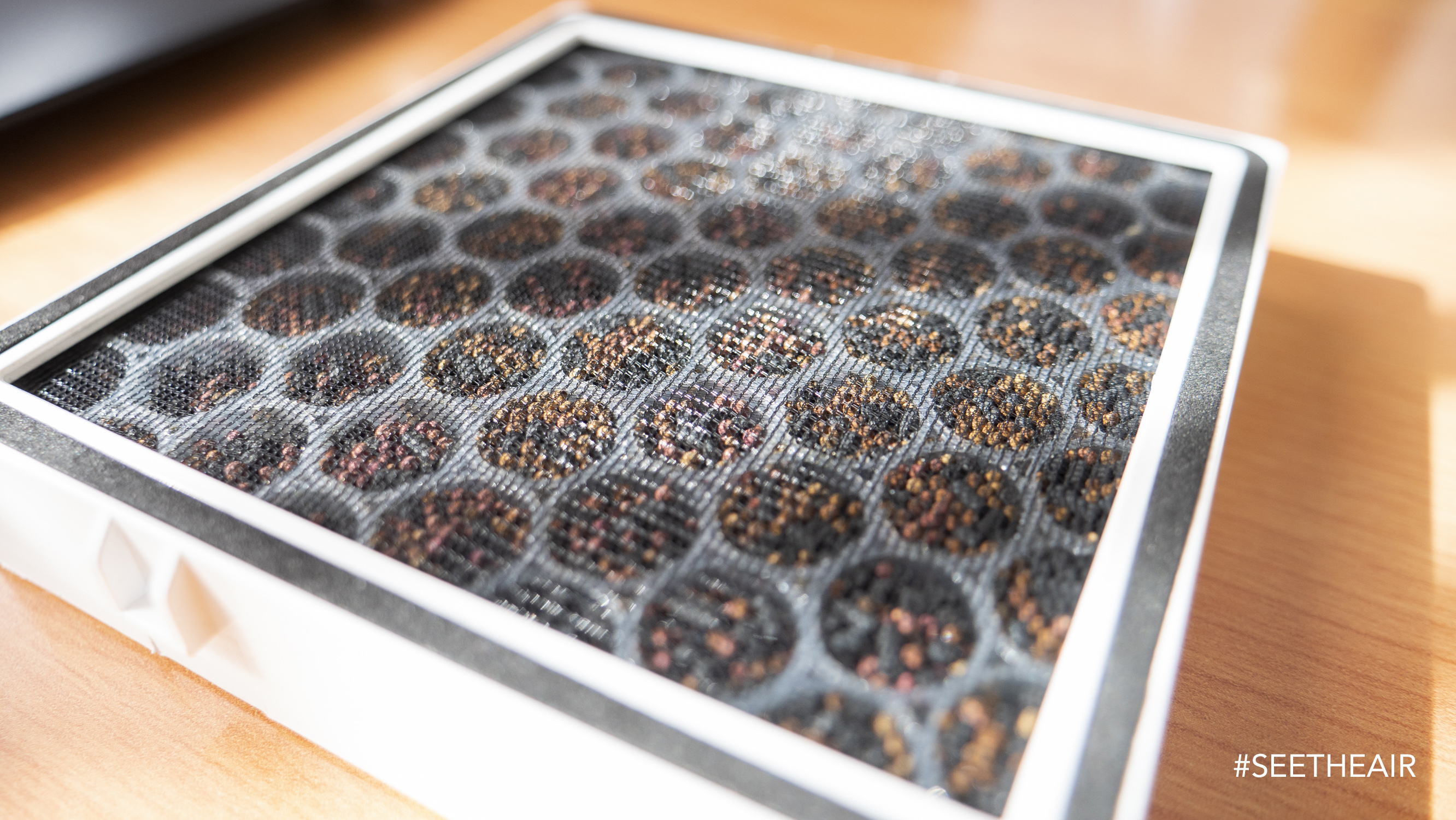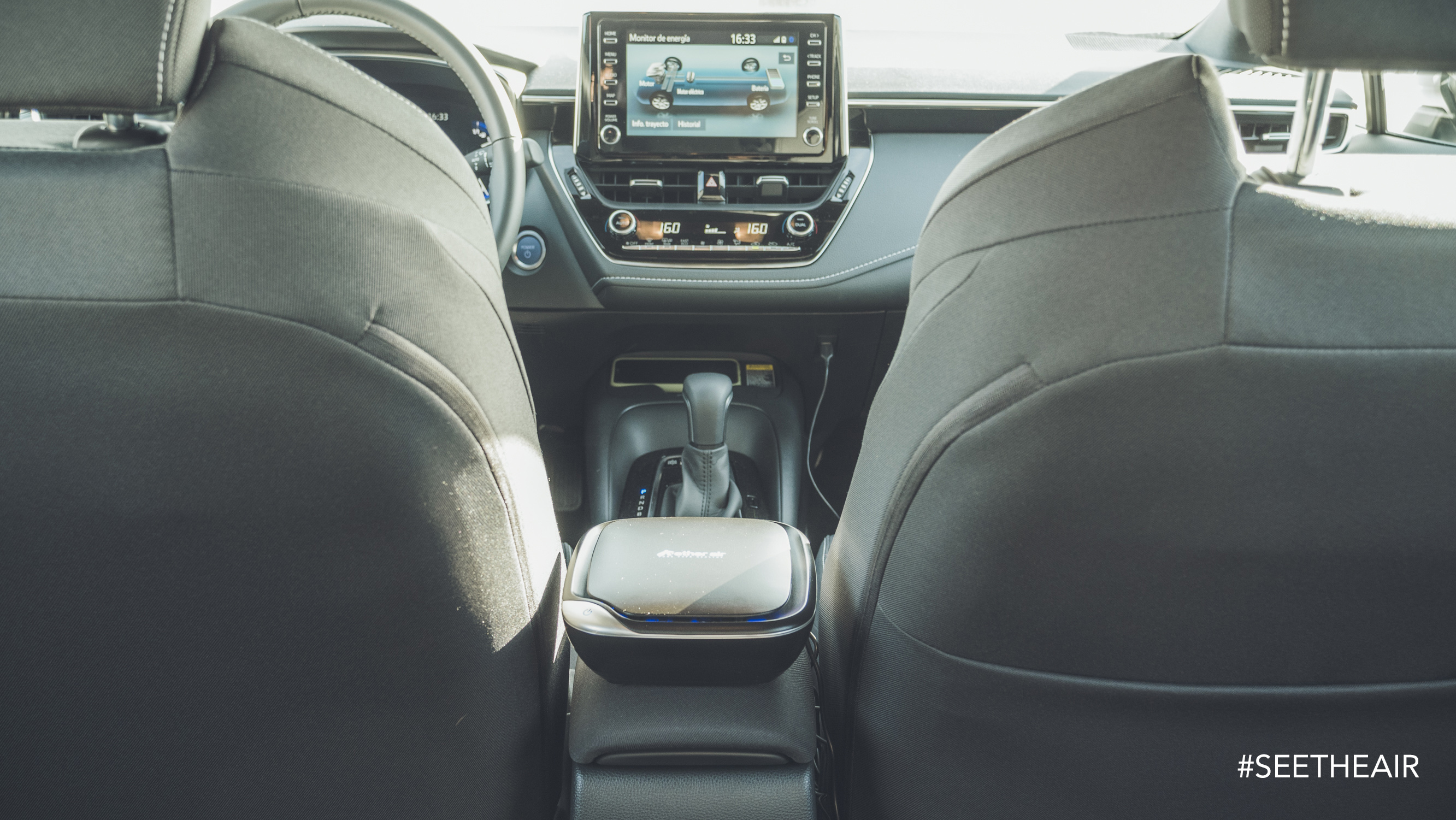Commuting to work is proved to contribute the biggest daily exposure to air pollutants according to the University of California. Car filters are not very good at filtering out PM1, PM2.5, and PM10 particles from vehicle emissions as they were originally designed to catch large particles like dust and pollen. Gas filtration is non-existence even today in any vehicle, as a result, drivers and vehicle passengers breathe notorious toxic fumes.
Although I believe that if you live in a city and you work in the same city, you should find a better way to commute, for some people this is not an option. Consequently, they need to find a way to protect themselves and mitigate their exposure to air pollution.
Aether Air HA30 is an in-vehicle air purifier capable of filtering particulate matter and eliminating nitrogen dioxide (NO2) among other chemicals.
It uses the same technology as the HA500 domestic purifier but in a smaller package. The D-Orbital Nano Oxide (DNO) filter, which is an innovative filtration system invented by the founding CTO of Oxford Catalyst plc (a leader in novel industrial catalysts)” and a HEPA 13 filter.
Specifications
- Formaldehyde CADR: 6m3/h (3.5CFM)
- Particulate Matter CADR 25.9m3/h (15.2CFM)
- Sensors:
- tVOC
- RGB LEDs
- Motor: DC motor
- Noise: max 53.8dB(A)
- 12V DC Car Lighter Adapter
- Power Consumption: 4.3 watt
- Size: 17.2 x 16 x 7.2 cm
- Weight: 0.92kg
Filtration Performance
The purifier draws air from the top and there are two vents on the right and left side of the cleaner. The Clean Air Delivery Rate (CADR) specification helps us understand better how fast the air purifier can clean the air within a particular size indoor environment, in this case inside a car. From the specs, we can see that the purifier has rather a small number for both Formaldehyde and Particulate Matter clean air delivery rate if we compare them with a home purifier but the normal space for a passenger car is 3m3/105ft3, so the CADR number is enough for normal car usage.
A denser HEPA filter like the H13 can give a lower CADR number but better filtration. Originally, I thought that such a small fan won’t be able to suck air but it was able thanks to the 24 double ball bearing, I tested it. However, I still believe an H12 HEPA filter would have delivered a higher CADR number. The company has chosen an H13 filter for better virus removal.
Basically, there is less airflow but the H13 can capture more particles. Only 50 from every 100.000 particles can escape, in comparison to the H12 where 500 from every 100.000 particles can escape.


My Experience
The purifier has LEDs (Blue for Good AQ, Purple for Poor AQ, and Red for Bad AQ) around the filter that change colors depending on the pollution in the car. It only measures VOCs so the indications are based only on this parameter. In my opinion, there is no need for a light indication because you drive a car anyways and your attention has to be on the street.
There is only one tactile button that controls the speed of the purifier (Auto/Low/Medium/High), additionally, it serves as the turn on and off button when you press it for a long time. The auto function is linked to the VOC sensor, so it will turn up gears when VOCs concentrations are high. I personally leave it at a medium speed to avoid excessive noise and achieve good filtration. The purifier can be placed on the back of the copilot/pilot’s seat but also you can place it in between the seats.


I had to bring a portable PM monitor with me in order to measure the effectiveness of the HEPA filter. It works, however, it is very important to control the origin of the air in a car because when you constantly bring outside air in, you also bring the pollutants but if you only circulate the inside air then CO2 builds up. Cars should have had the technology to switch automatically from outside air to inside air when pollution increases on the ambient air and vice versa when CO2 builds up.
I rarely use a car because simply, it doesn’t worth it, but the air purifier makes me feel more secure while I am inside. Walking and cycling is more fun!
Conclusion
All in all, even electric vehicles produce particulate matter pollution because of the friction of the brakes and tires on the asphalt. Aether Air HA30 is designed to offer an additional layer of protection for the passengers in any vehicle. It definitely offers protection to those that care for their health and well-being.




Discover more from See The Air
Subscribe to get the latest posts sent to your email.


There are also cabin air HEPA filters for most car brands that are easy to change/upgrade e.g. from Bosch (some even have carbon included). This might reduce the PM2.5 coming in from the outside air and thus helping to achieve both acceptable CO2 range and low PM2.5.
LikeLike
I didn’t know it, and seems very interesting. I’ll try to find one for my car and check if there is an improvement. Also, I’ll have to check which one do i have now and how to change it 😛
LikeLiked by 1 person
the exhaust gases of the car cannot be cleaned by anyone. You can catch microparticles of carbon black with a filter, but this is only part of the concerogens. Perhaps in a year, I will be able to integrate the submarine analogue cleaning system into the car.
LikeLike
[…] were high hence higher average PM concentrations. Also during my trip, I had an air purifier with HEPA H13 filter installed in the vehicles so the concentrations during these ~4000km were really low (~2.5 […]
LikeLike
[…] See The Air is an air pollution influencer, he gave healthy air technology ltd’s car air purifier HA30 a fair and independent review. Car unit review by See the Air can be find here. […]
LikeLiked by 1 person